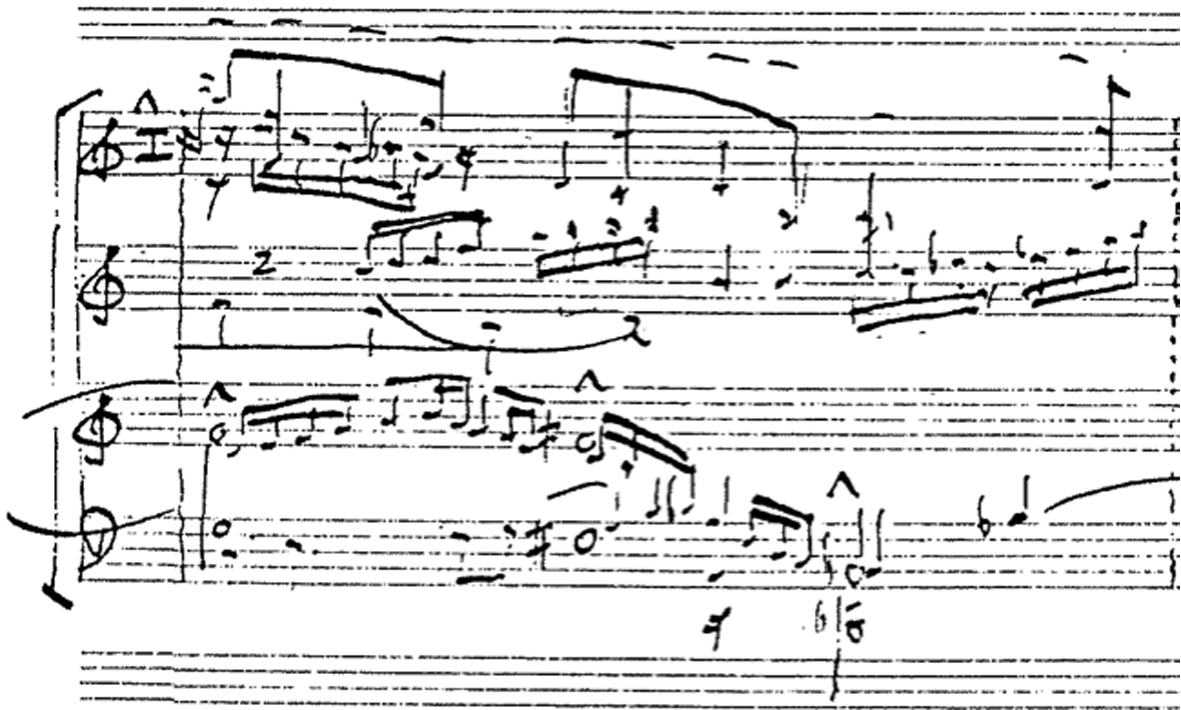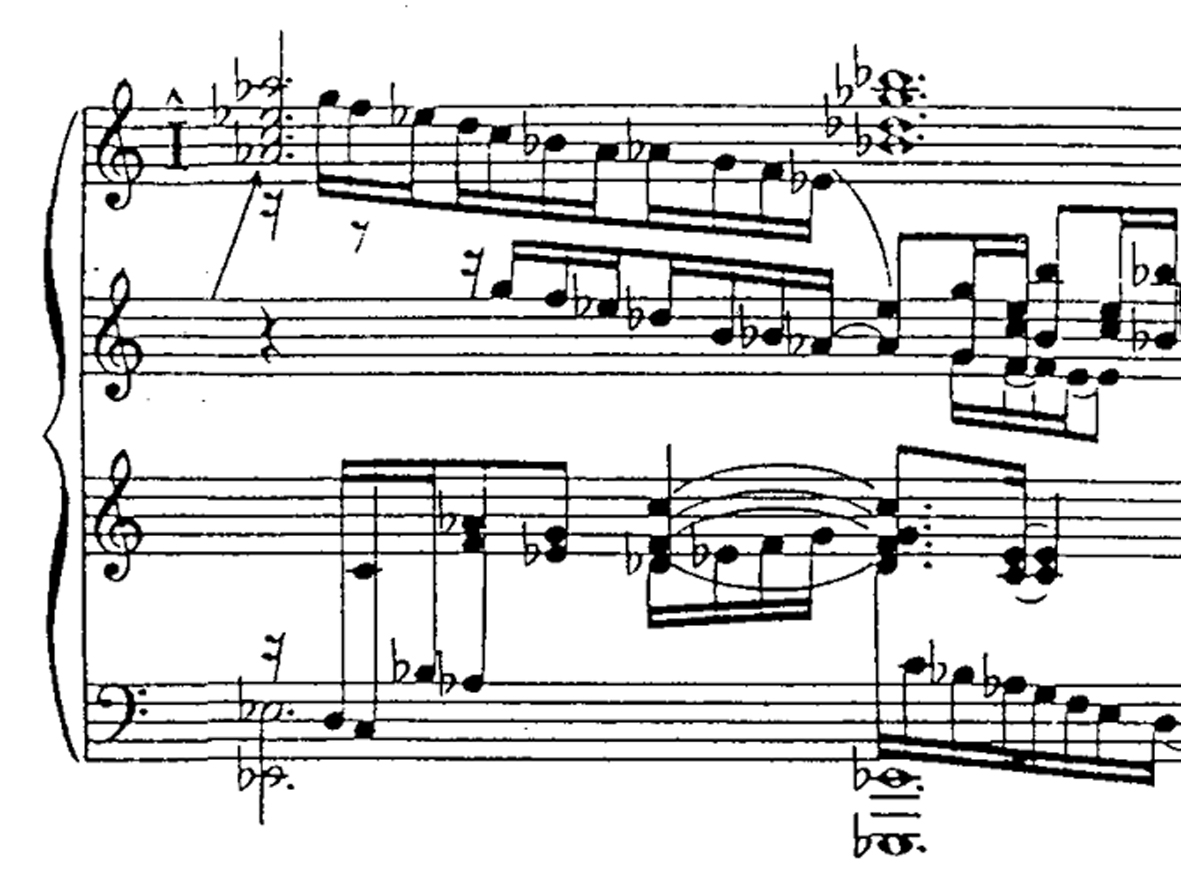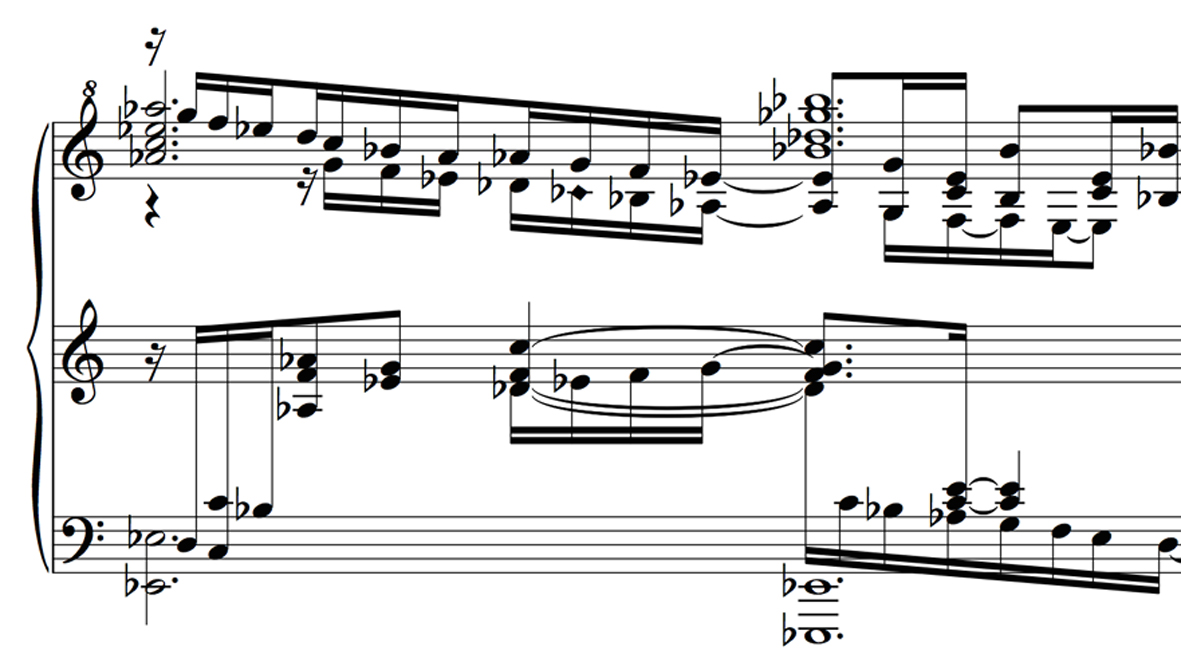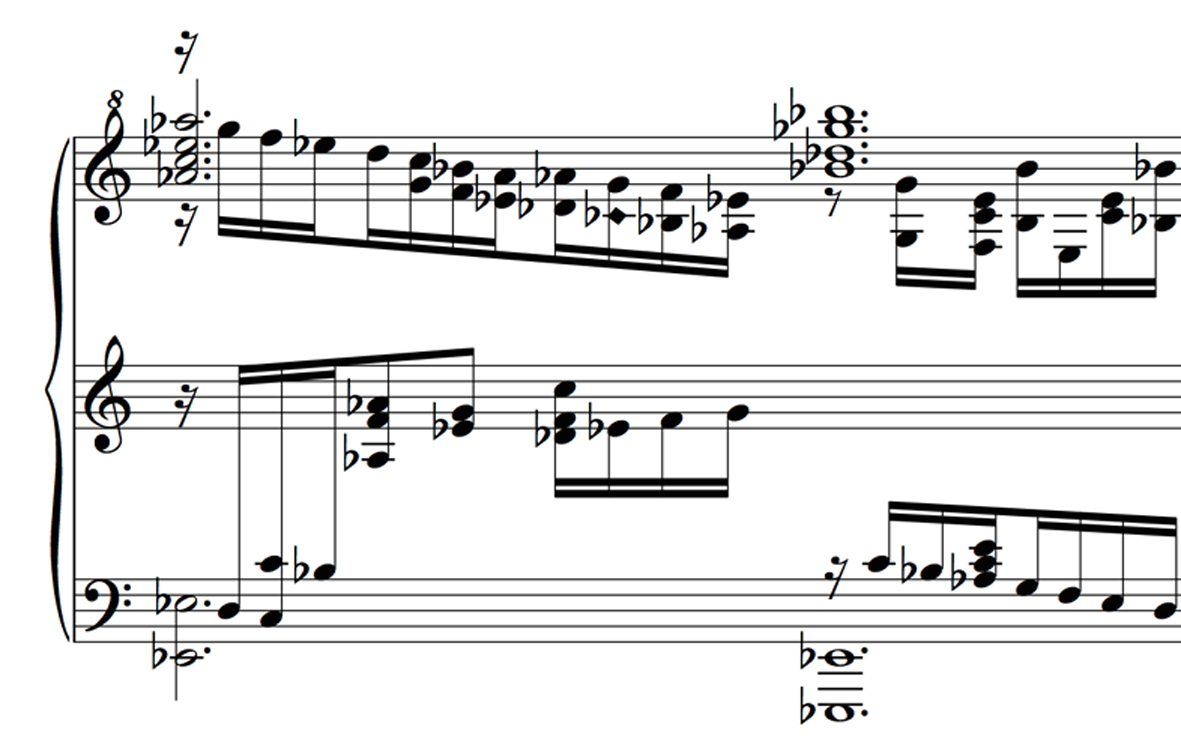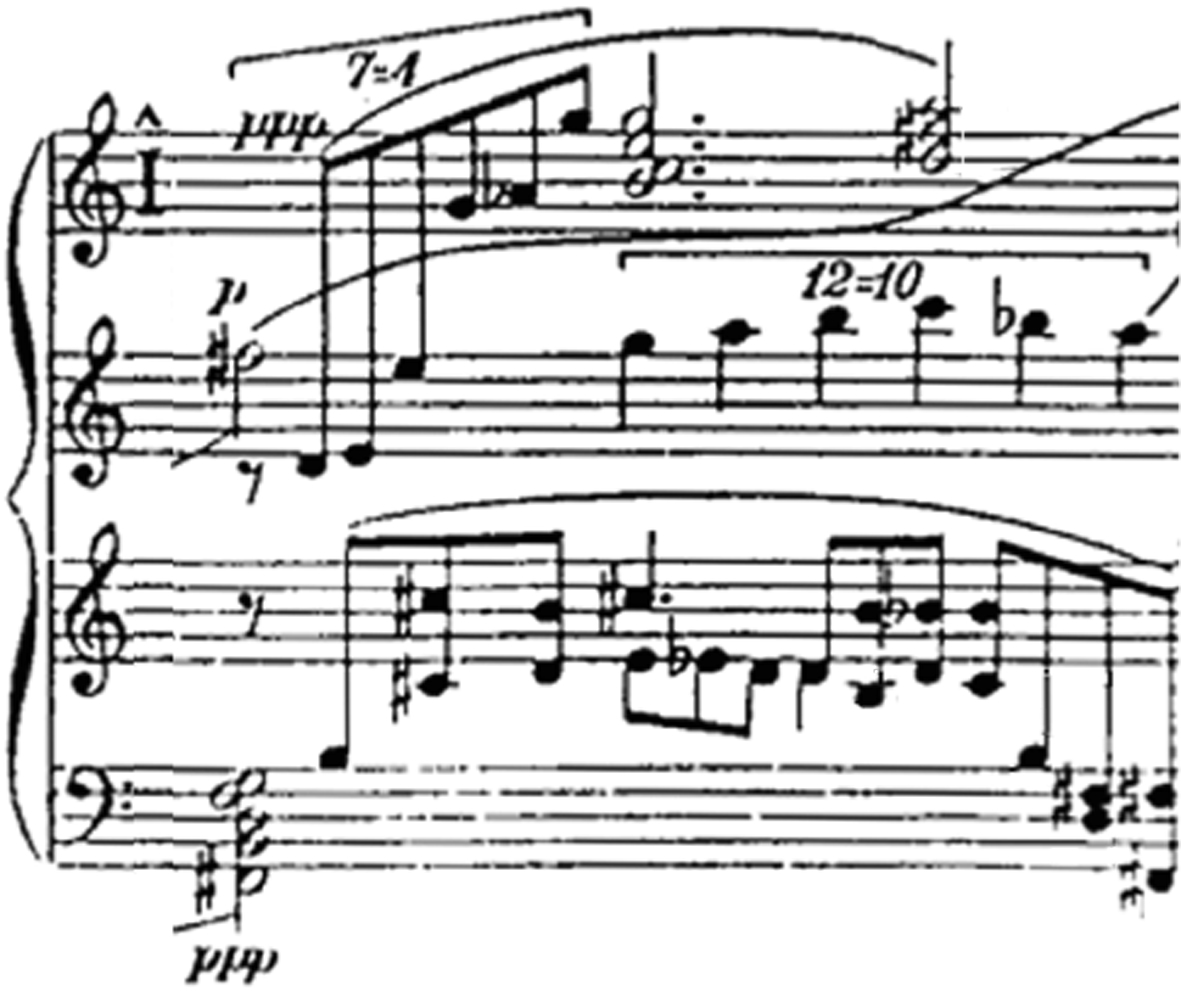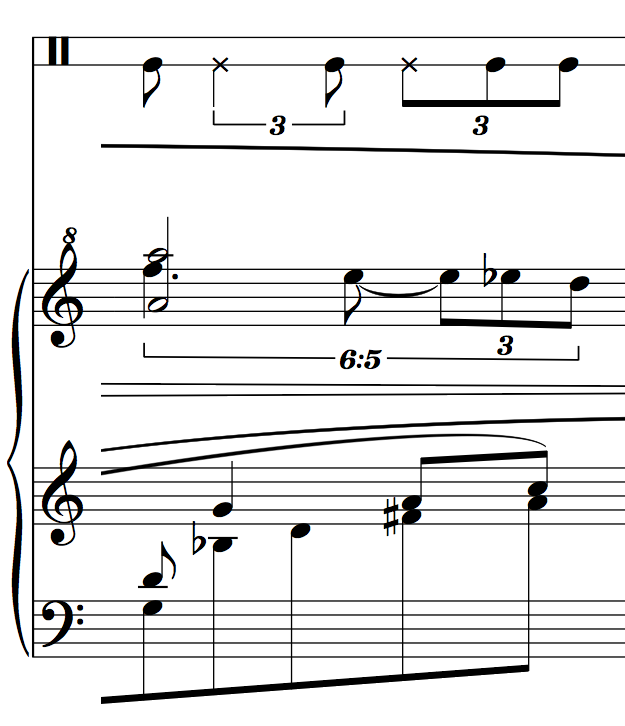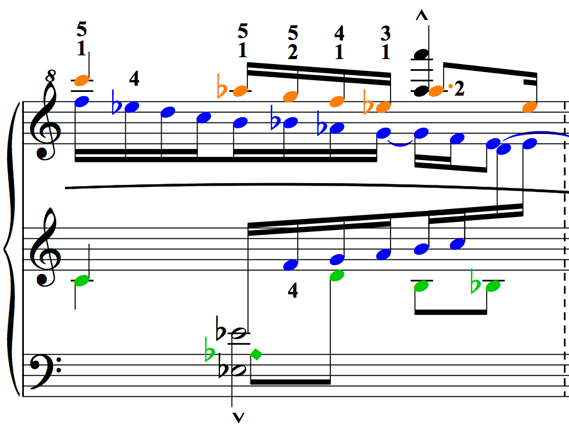INTRODUCTION
A SCORE is a set of instructions for a flow of physical movements (kinesthetic) and mental gestures (rhetoric) in time, which ultimately result in a sonic outcome. Historically, the music notation system began as a mnemonic device, which showed within a certain degree of freedom, how a text was to be performed. Over the centuries, this system evolved to contain more precise notation of the musical parameters. Obviously, composition practice spurred these developments, by generating new ideas that needed new or more specific ways of notation, on to ever growing complexity. An example is the evolution of music notation in the Klavierstücke by K. Stockhausen, most notable prior to the Licht-inspired pieces. This process culminated in the 20th-century modernist and "new complexity" music. In a piece such as Time and Motion Study II from 1973-76 by B. Ferneyhough, notation reaches a very high density of information and level of detail. However, a considerable and important distinction should be made between a one-to-one relationship between notation and sonic outcome, as in the works of K. Stockhausen; and a one-to-many relationship between notation and sonic outcome, as in the works of Ferneyhough and M. Finnissy. The one-to-many relationship implies an indirect approach, in which more emphasis is given to the performers' responsibility to transform notation into music. Given these degrees of freedom, a much greater personal contribution of the performer is required. Essentially, in their works, Ferneyhough and Finnissy expose the problematic nature of notation itself (Kanach, 2010; Ferneyhough, 1995). It is therefore justified to say that the intrinsic elusiveness of music notation stems from the incomplete nature of symbols and their associated sonic outcome. Performance traditions that make up the context in which the symbols function are mostly poorly documented (Kivy, 1998). Nevertheless, notation and performance tradition capture the aesthetic scope wherein – or against which – the artist can reproduce an artwork.
Given this background, it is often tempting for performers to make their own critical performing edition in which they include their own well-researched answers to technical or interpretational questions, rather than using the Urtext edition. This is especially the case when complex score notations have to be dealt with, and when composers deliver scores that ignore some basic mapping mechanisms such as the horizontal and vertical order of pitches and rhythms. Performing editions can not only be understood in the way composers such as F. Busoni devised them, containing interpretational guidelines and thus being subjective interpretations of the music, but can also contain technical deciphering and answers to technical issues the composer overlooked. As Sorabji's scores lack most interpretative directions, the interpreter is invited to think as a recreator trying to understand the music from within (Rapoport, 1992). Of course, some composers do go through the process of seeing their music through the eyes of the performer. Some of them indeed try to anticipate possible ambiguities a performer might encounter. This is a kind of craftsmanship that is strongly present in the works of composers such as Ferneyhough or G. Ligeti; foremost on an interpretative (Ferneyhough, e.g. Lemma-Icon-Epigram) and technical (Ligeti, e.g. Etudes) level.
The first author has a lot of experience in playing technically demanding music, such as works of Ferneyhough, Finnissy, I. Xenakis, and Sorabji. As a performer he was also involved in preparing critical Urtext editions of some works by Sorabji. This article will therefore focus on a score written by Sorabji, the Opus Clavicembalisticum of 1931. The question was whether it is necessary to rewrite this complex score. We hypothesized that particular performer-related issues, such as a proper ordering of notes according to the player's "embodied" approach to music, could be beneficial for the study process (shorter study process) as well as for the final sonic outcome (fewer errors). To examine this research question, we conducted an experiment in which we analyzed the playing of nine pianists. In the next section we shall describe Sorabji and his music, discuss different types of editions and the reason why a new, so-called "embodied edition" may be needed. Furthermore, we shall describe the experiment and the methods we relied upon for analysis. In the penultimate section, we shall describe the results of said analysis, and this section is then followed by a discussion of the general relevance of our study.
BACKGROUND
Sorabji and His Music
Kaikhosru Shapurji Sorabji (1892-1988) wrote 61 works for solo piano, of which only nine were published before the middle of the 1930s. The last of these publications was the Opus Clavicembalisticum (henceforth called the OC) in 1931 (Roberge, 2013). Because of unsatisfying performances of some of his works, not in the least the OC, Sorabji instated a ban on public performances not approved by him in 1942 and ceased to publish his new works. Starting from the late 1970s the composer systematically granted permission for all public performances (Rapoport, 1992). The Sorabji Archive was established in 1988, this led to the publication of works written after the OC, which resulted in a renewed interest by an international audience. Editors, by this time, had become more competent and a clear discrepancy exists between the old editions, which contained many errors, and new critical Urtext editions. This discrepancy is very clear in the OC, due to its unusual length and complexity. The growing interest in Sorabji's music resulted in many concerts worldwide, as well as new record-ings. However, there is also a need for new error-free editions of all of his works. The question then arises, what kind of edition should be made; critical Urtext - or performing, or both, depending on whether it is meant primarily for the eyes of the scholar or the hands of the performer (Edwards, 2002). Similar questions are often asked in relation to Xenakis' music where similar problems exist (Kanach, 2010; Hill, 1975).
Types of Editions
It is likely that the type of edition somehow influences the performer's processing of the score. If the relationship between the edition and the performance is as strong as Edwards (2002) claims in a case study on the OC, it can be beneficial to opt for a performing edition. Changes Edwards suggests include reducing the number of staves simultaneously in use, redistributing notes on those staves, regularizing the use of accidentals, and clarifying complex rhythms. This would make it easier for a performer to learn the piece. Such an edition would, through the notation and the type setting, show how the music is to be played; instead of an Urtext edition, showing primarily how the music was composed. Therefore, it would be of interest to have a performing edition that does not impose a certain musical interpretation but instead answers technical questions in an objective way. This can be done for example by providing the performer with a full analysis, giving more background information about the composer and the piece, and giving solutions to technical problems such as fingerings, hand distribution and rhythmical synchronization between left and right hand. Performers using such a performing edition should thus gain extra time both to practice and work on an interpretation, given that such an edition removes the need to fully analyze or rewrite these complex and possibly long scores themselves. A performing edition can not only present the composer's intention more clearly, but it will also provide a considerable amount of the notation-to-performance decoding that is typically needed to be able to play when such musical complexity is involved. As Sorabji approved a performing edition of his Fantasiettina sul nome illustre dell'egregio poeta Christopher Grieve ossia Hugh M'Diarmid (1961) made by Ronald Stevenson, it can be argued the composer himself believed the musical content in the score isn't changed by the way it is presented to the performer. However, as the opinions are divided on the value of performing editions of Sorabji's music, a closer exploration of this topic is needed (Rapoport, 1992).
A first and necessary step when making a new edition of the OC is to analyze where the errors, such as simultaneously occurring melodies of different lengths (see Fig. 1), and performer-unfriendly notation in the Urtext edition published by Curwen & Sons LTD, originated (Edwards, 2002; Rapoport, 1992). These errors could imply that a literal realization, a one-to-one-relationship between score notation and sonic outcome, was not of great importance to the composer. After comparing the published 1931 edition with the original proof print and with the manuscript, it becomes clear that errors in fact exist in all three versions despite the fact that the composer corrected the proof print as well as the published version. The main reason for this seems to be that Sorabji composed quickly and without drafts (Owen, 2006; Rapoport, 1992). Consequently, this resulted in many mistakes against the logic of music notation, as well as many instances where the notation is unclear. Therefore, an editor typesetting Sorabji's manuscripts, needs not only to determine which notes are written in the manuscript, but also which notes were actually intended by the composer. Corrections can be deduced by making a thematic and motivic analysis of the music and comparing the findings to all of Sorabji's corrections. The analysis of the work shows an elaborate underlying musical logic, which is not always compatible with the proposed corrections. A reason for this incompatibility may be that Sorabji appears to have been a rather impatient person who did not take the time needed to thoroughly correct the proof prints, nor the final edition (Rapoport, 1992). Striking examples of such errors are passages in the manuscript that cannot be corrected without changing the score considerably. In these instances, editors need to act as composers in their own right in order to correct these passages.
Sorabji was not only impatient when writing down his ideas and proofreading scores; he was also impatient with performers. He believed that pianists would continually improve their technical abilities, which led him to write music that is extreme difficult to play, containing complex rhythms, a high degree of polyphony, a high number of notes per second and extremely long duration. Some pieces last up to 9 hours (e.g. his Symphonic Variations from 1935-37). Because he was financially independent, he could focus on composing, rather than trying to get his compositions performed (Owen, 2006). Although Sorabji greatly valued his compositions as well as their publication, he wrote an ironic remark to the dedicatee of the score of the OC, "[…] and now he [E. Chisholm] can amuse himself noticing the enumerable discrepancies between the published version and the manuscript — which ought to keep […] his mind […] well occupied for a long time to come!" (Sorabji, 1930). This ambiguous attitude, and the great level of complexity and length of his musical works, has led some performers to doubt the necessity for a correct sonic realization of all pitches and rhythms notated in Sorabji's scores. As a consequence, some performers adopt a holistic approach, taking complex sections in extreme cases as the basis for an elaborate improvisation.
In contrast to his impatience in notating and proofreading, many statements by the composer also reveal an exacting nature. For example, in a letter to a performer he wrote, "the music as printed embodies my INTENTIONS" (Sorabji, cited in Rapoport, 1992, p. 362, emphasis his). Furthermore, the introductions to his fourth and fifth piano concerti contain practical guides for the performer, favoring a slower but precise rendition and advising against memorization to avoid mistakes. A note on the score of the OC even states that his music is intended "for pianist-musicians of the highest order" (Sorabji, cited in Rapoport, 1992, p. 256). Sorabji's musical tastes, which he expressed in many concert reviews, show his preference for the late Romantic period, especially Busoni and K. Szymanowski, and pieces containing "infinite richness" in the form of abundant detail (Sorabji, 1932, p. 118). These and similar statements have led to the situation that most of the current generation of piano performers adopt a traditional performance approach, using an exact realization of the scores as a basis for musical interpretations. Even though opinions have been divided on the matter, it should be noted that most pioneers in playing Sorabji's music also favored this approach. Practicing the music of this composer, however, remains a difficult task, mostly due to the combination of tuplets, the amount of polyphony, and the speed and unseen length of many of his works.
An "Embodied Edition"
The secondary claim made in this article is that a new edition should take into consideration the embodiment of piano performance, which a musician automatically takes into account in order to decipher a score. Research in the field of score-reading shows that the recognition of musical patterns resembles the recognition of words. A musician thereby draws upon a vocabulary of patterns that are associated with playing movements. This vocabulary implies that a musician favors patterns that are used more often (Patel, 2008; Waters et al., 1997, 1998; predicted by Sloboda, 1978). Along these lines, Rubin-Rabson formulated a theory as far back as 1940 about the learning process of music and musician's intuitions in general. She concluded that a musician starts to memorize kinesthetic images from the first contact with the score. Thus in this first stage of learning, fluently recognizing the different patterns is of key importance.
Recent research in the field of music cognition and related neuroscience confirms these results. Antoniadis (2011, 2010) describes the interaction between patterns in the score and bodily patterns. He argues that dealing consciously with those movement patterns facilitates the learning process. The ideomotor theory of music cognition (Hommel, 2013; Leman, 2008) assumes that associations are formed between perception and imagination on the one hand, and motor activities or actions on the other hand. This association facilitates playing because the perception of patterns can become directly associated with action patterns. Seeing a pitch structure is then directly associated with an action pattern for playing. This can be done by, for example, respecting the vertical order (pitch) of the score in relation to the movements (left-right) on a piano keyboard. However, in Sorabji's scores, often many staves are used simultaneously, sometimes even with crossing clefs (e.g. treble clef under bass clef). In contrast, a standard use of accidentals, e.g. not using sharps and flats in the same chord, using sharps in ascending lines and flats in descending, in other words referring to standard tonal chords, and avoiding motives and chords that are to be played by one hand being spread out on multiple staves, enables a quicker recognition of chords or motives in this context of complex and mostly atonal music. Adding analytic markings to the score, such as themes, important structural elements, coherent groups of events and structures makes the music easier to understand and, therefore, to remember (Williamon & Valentine, 2002). In complex rhythmical situations, adding basic beats and synchronization lines would also help the performer to decipher the score.
In short, with experienced pianists we may assume that the decoding of notation to performance is an automated process. This association typically favors patterns that have been trained, or patterns that are so-structured that they can be easily linked to previously internalized motor patterns. An "embodied notation" would be such that this ideomotor aspect is optimally exploited. Such an "embodied notation" would fully explore the pianist's action ontology, which is the repertoire of notation-action associations (Leman, 2008). The major gain is that the cognitive load needed to process the complexity of the notation can be reduced and delegated to the existing automatisms, so that the cognitive resources can be fully devoted to less familiar complexities, and the expressive performance of the music in question.
EXPERIMENTAL SETUP
In what follows, we assume that an "embodied edition" of the OC will have a positive effect on the learning process. We further assume that such an edition will result in a less erroneous rendition. Factors such as differences in psychological impact of the different editions on the performer and how they interact with the musical content in the score were not taken into consideration as this would open up a discussion that lies outside the scope of this article. Such factors include the feeling of tension when seeing the degree of difficulty as Ferneyhough describes, or the link with orchestral reductions and thus different use of timbre when Sorabji uses multiple staves simultaneously.
Stimuli
For this experiment three movements from the OC were taken, representing three distinct styles (or musical textures), each having their own distinct technical challenges. The first movement, entitled Cadenza I, is written in the "motoric genre" (Rapoport, 1992, p. 352, see Fig. 2a), and contains sections with up to seven superimposed melodies that aren't returning themes. The second movement, entitled Adagio, is one of many nocturne-type compositions written by this composer, where a "steady, prose-like flow", as Sorabji called it, is achieved by simultaneously combining up to three tuplets of different speeds and lengths (Rapoport, 1992, p. 362, see Fig. 3a). The third movement, Coda-Stretta, is a "cataclysmic and catastrophic" web, mainly consisting of four themes that were introduced in the fugue preceding this movement (Sorabji, cited in Rapoport, 1992, p. 310, see Fig. 1). These themes are presented in different speeds, registers and rotations, and they form a fabric of up to eight-part counterpoint.
From each of the three chosen movements we selected three fragments of similar lengths (approximately 100 notes each), containing one musical unit (a phrase or a similarly closed musical unit). This resulted in nine selected fragments, which were then prepared in three editions, the original Urtext edition (U), a performing edition (P) with only a few features changed, and a more heavily edited study score (S), the two latter taking into account the concept of "embodied notation" (see Fig. 2a-c above). For U a slightly adjusted original published edition was used, so that all three versions would contain exactly the same pitches and rhythms, but in different typesettings. In P a visual reduction was made according to the suggestions mentioned earlier, which Edwards (2002) described: maximum three staves in total and maximum two of them simultaneously were used. S used P as a starting point, but the non-thematic polyphony of Cadenza I was reduced. Rhythmical aids (both divisions with the same rhythmical result and approximations as described in Nauert, 1994) were added to the Adagio (see Fig. 3b below), and colors were used in the Coda-Stretta to make the fugue themes clear. In the three fragments from the Coda-Stretta fingerings were added (see Fig. 3c below).
Participants
The participants, all experienced pianists, were at the time of the experiment aged between 21 and 39 (M=30.2, SD=6.2), 4 female and 5 male. They were given the instruction to keep a log of their study time and write down their experiences during the learning process. After the recording, participants were given a questionnaire about the number of years of experience as a musician, their familiarity with contemporary music, their ability to sight-read, and the ease with which they are able to learn a new score. Other comments on and reactions to the different score types were gathered in a semi-structured interview. The number of years of piano experience they had ranged from 14 to 32 (M=23.2, SD=5.6). All questions involving estimates (e.g. self-perceived sight-reading capabilities) were answered on a visual analog scale for maximum flexibility.
| Contemporary music (% played in last 5y) | Difficulty experiment (%) | Quick learner (%) | Sight-reader (%) | |
|---|---|---|---|---|
| Participants 1-9 | 85 | 20 | 20 | 32.5 |
| 80 | 50 | 90 | 87.5 | |
| 60 | 58 | 28 | 50 | |
| 50 | 68 | 60 | 43 | |
| 75 | 83 | 88 | 93 | |
| 15 | 97.5 | 55 | 25 | |
| 17.5 | 100 | 67.5 | 50 | |
| 100 | 87.5 | 55 | 55 | |
| 50 | 50 | 37.5 | 12.5 |
Procedure
Three fragments from each of the three movements (numbered from 1 to 9) were distributed amongst the nine performers, using the same order of musical fragments but different orders of score versions per movement per participant. All participants got exactly one week to learn to play the nine fragments, during that week they were asked to practice as they would normally do for a concert. The experiment itself consisted of a single recording on a MIDI-enabled (Musical Instrument Digital Interface) acoustic upright piano. Recordings were made in a quiet environment after 15 minutes of preparation. For the first three participants, a recording was made in the showroom of Jacek & Svetlo piano company in Ghent (BE), the next six participants played on the same model of piano in the Orpheus Institute in Ghent (BE). Study time per fragment, rounded to a minute, was kept in a logbook and also analyzed separately. See Table 2 for a schematic overview of the experimental setup.
| Opus Clavicembalisticum | |||
|---|---|---|---|
| Movement | 1 (Adagio) | 2 (Cadenza I) | 3 (Coda-Stretta) |
| Fragment | 1,2,3 | 4,5,6 | 7,8,9 |
| Version | U-P-S (order changes) | U-P-S (order changes) | U-P-S (order changes) |
| Participant 1-9 | MIDI-recording, study log, score annotations, questionnaire | ||
Data Analysis
The MIDI recordings were analyzed with the performance-to-score matching algorithm developed by Gingras and McAdams (Gingras et al., 2015; Gingras and McAdams, 2011). This code is able to com-pare a MIDI recording to a score and analyze pitch and rhythm errors. The type of performance errors (substitutions, intrusions, displaced attacks, untied notes, added ties, omissions, timing errors) is also categorized by Gingras and McAdams' algorithm, and was used to distinguish between rhythm and pitch errors. For this analysis the percentage of score notes omitted or performed with errors was used. Annotations on the scores used by the nine participants to prepare for the experiment were also counted. By counting the number of fingerings, synchronization lines, and left-right hand distribution marks which the performers added to the scores, it was possible to see which of the different score versions (U, P, S) met the performer's needs best. Each fingering, hand synchronization line, or hand distribution line or bracket was counted as one unit. The statistical analysis employed linear mixed models (Laird & Ware, 1982), which allow the estimation of both excerpt- and performer-specific effects in a single model. Here, performer was treated as a random effect, whereas piece and version were treated as fixed effects, and the percentage of contemporary music played in the last five years, the difficulty of this experiment compared with current artistic practice, and the performers' self-reported study speed and sight-reading capabilities were treated as covariates. All statistical analyses were conducted in IBM SPSS Statistics (version 23.0.0.0), with significance level (alpha) set at .05 for all tests. Normality was tested using the Kolmogorov-Smirnov normality test in SPSS and confirmed for the variable study time. It should however be noted that the normality assumption is not regarded as a stringent assumption for linear mixed models (Gelman & Hill, 2007).
RESULTS
Objective Analysis
| U | P | S | Total | |||||||
|---|---|---|---|---|---|---|---|---|---|---|
| M | SD | M | SD | M | SD | df 1 | df 2 | F | p | |
| Study time (min) | 51 | 19.7 | 42 | 15.2 | 41.9 | 10.9 | 2 | 68 | 3.834 | .026 |
| Errors (%) | 24.7 | 17.1 | 21 | 13.8 | 19.3 | 14.7 | 2 | 68 | 1.739 | .183 |
| Rhythm errors (N) | 9.1 | 15.9 | 5.9 | 2.9 | 8.7 | 18.9 | 2 | 68 | 0.47 | .627 |
| Pitch errors (N) | 31.4 | 23.6 | 27.2 | 18.5 | 25.7 | 19.6 | 2 | 68 | 1.516 | .227 |
| Duration (sec) | 200.8 | 107.2 | 193.6 | 82.5 | 195.5 | 948 | 2 | 68 | 0.13 | .879 |
| Fingerings (N) | 28.7 | 28.9 | 29 | 30.5 | 25.3 | 33.3 | 2 | 68 | 0.473 | .625 |
| Hand distribution lines (N) | 3 | 4.3 | .8 | 1.1 | .6 | 1.1 | 2 | 68 | 8.213 | .001 |
| Hand synchronization lines (N) | 2.5 | 3.5 | 1.3 | 2.2 | 1.5 | 2.4 | 2 | 68 | 2.293 | .109 |
Note: N refers to the total number of cases.
A significant influence of the score type on the study time, F(2, 68) = 3.83, p < .05, and use of hand distribution lines, F(2, 68) = 8.21, p < .01, was found, F(2, 68) = 3.83, p < .05, despite significant differences of study time between the movements from the OC from which the fragments were taken, F(2, 68) = 5.4, p < .01. In other words, regardless of the musical texture, the P and S score types reduce the study time compared to U. For a complete overview of the analyses, see Table 3. There was no significant influence of the score type on the number of errors, in general nor on rhythm or pitch errors specifically, only a positive tendency. Correlational analyses further clarified some points as can be read in the following paragraphs.
As could be expected, a strong link between the number of rhythm errors and the chosen tempo was found, F(1, 30.27) = 6.42, p < .05. Curiously, this was not the case for pitch errors. The movement from the OC the fragments came from was a significant influence on the number of errors in general, F(2, 68) = 4.17, p < .05, due to the influence on pitch errors specifically, F(2, 68) = 18.35, p < .01. This would imply that there is no need for rhythmical aids to be printed in the score, such as rhythmical approximations or synchronization lines. A weak but non-significant influence of the score type on the number of added synchronization lines, however, makes strong conclusions impossible.
The use of fingerings differed significantly between musical textures, F(2, 68) = 8.23, p < .01, however this was not the case between score versions.
No significant influence of the variables from the questionnaire was found, likely due to the small number of participants.
Subjective Analysis
All comments the performers gave were analyzed; neutral comments were ignored in this overview. See also Table 1 for the results from the questionnaire.
Regardless of the musical texture (Adagio, Cadenza I or Coda-Stretta), one performer found the use of a transposing clef confusing, while another found it an effective aid to visualize the vertical relationships of the music.
In general, most performers (six out of nine) liked the added rhythmic aids in S in the Adagio texture. One performer did not use them, one complained that he felt lazy when doing so and suggested it might create false downbeats that would restrict his freedom (he had the most years of performance experience). One performer emphasized the usefulness (in P&S) of a reduction from 4 to 3 staves. Two performers however favored the 4 staves, which gave them a better overview.
The Cadenza I proved to be a difficult score to practice for four of the nine performers. Two performers said it was hard to find a good fingering, but that it was a necessary step in deciphering the score. Using the S version with a reduction of non-thematic polyphony to chords (see Fig. 2c for an example), one performer remarked that a lot of the musical refinement was lost. The visual reduction to three staves was strongly favored by three performers, who all found the experiment rather hard, compared to their normal daily practice.
Three out of the nine performers liked the added colors in the S version of the Coda-Stretta (they were rather bad sight-readers in their own opinion). However, they distracted two other performers, and one of them thought using colors for themes was not very useful (they were rather good sight-readers in their own opinion). One performer liked the added fingerings, but one found them too complex. It should be noted that the fingerings added by the editor took the polyphony into account instead of chord groupings. Three performers emphasized that the staff reduction in versions P and S was very useful (they were also rather good sight-readers in their own opinion), but one performer liked the suggestion of space in the four-staff U version. Finally, three performers found the Coda-Stretta hard to understand musically and conceptually.
DISCUSSION
Discussion of Results
The results reveal that the edition indeed had a significant effect on the study time. Moreover, by analyzing the performer's markings on the score, it was possible to deduce what kind of elements were actually missing in the edition. A possible explanation for the reduced study time due to the difference in score type used could amongst others be found in the significant difference in adding distribution lines between the U and the two other versions, F(2, 68) = 8.21, p < .01, irrespective of the musical texture. In other words, the key decision in making the score more performer-friendly is to present the musical material in an ordered way, reflecting closely the movements of the hands on the keyboard.
From the performers' comments gathered afterwards, it became clear that they, on average, preferred added markings, such as aids for the complex rhythms in the Adagio, fingerings and synchronization lines. The lack of significant influence of the score type on the amount of added fingerings comes most likely from the fact that performers sometimes changed the proposed fingerings, for example choosing not to use the complicated fingerings in the fugue texture to enable polyphonic legato, and adding own fingerings using chord blocks as a starting point.
The use of colors in the study edition, which was intended to mark the polyphonic structure, clearly distracted some performers. However, we believe that this might have been due to the brightness of the colors which might have been slightly disturbing, rather than the use of colors per se. Using darker shades of color may be a useful compromise for combining a fluent study process with an analytical performance. The visual reduction to three staves was strongly favored by three performers in general. The others didn't mention it, apart from two performers who would have liked more space between the musical materials respectively in the Adagio and Coda-Stretta fragments.
The transposing upper staff, a trademark of the music of Sorabji, which lends the score a clear visual relation to the pitch material, was found to be confusing by one performer and very useful by another. In the first author's opinion, the transposing staff is a better way of presenting the score, rather than using local "octava" signs or many ledger lines. The latter, however, retain the vertical relations between the different musical elements even more. Overall, the results confirm our hypothesis that an "embodied notation" reduces study time. However, there is little or no effect on errors played, although we first assumed that "embodied scores" would have an effect here as well. This result can be explained by the fact that learning implies a memorization of motor patterns. The edition had no effect on the memorization in relation to error-prone playing. However, it did have an effect on the time needed to memorize the score. Finally, it should be noted that a balance between a realistic setting and a controlled approach was aimed for.
General Discussion
Our findings support the theory of "embodied music cognition" and its application to the domain of music reading (Antoniadis, 2011, 2010; Leman, 2008; Schick, 2002). Our results emphasize the importance of the score as an action map for the performing body, and not simply as a set of abstract instructions with resulting movements. We therefore believe that performer-friendly scores can be of great value in the hands of an experienced pianist who is learning to play a technically demanding work. An "embodied edition" can function next to a critical Urtext edition, which provides the performer with information that he or she might need to answer questions and form hypotheses.
In the light of the above findings it is of interest to consider what kind of notational organization should be taken into account in order to optimize the relation between notation and performance.
Pitch complexes are recognized by the relative distances between constituent notes. Simple patterns such as chords composed of thirds or scale figures composed of seconds are easy to recognize, as are common chords as triads and their inversions or octaves. These patterns are directly linked to muscle configurations, and can thus be realized spontaneously. Patterns that start from these oft-recurring patterns but are changed in a minor way are also easily decoded. When e.g. a major triad is broken up between two staves, the relative distances are lost, and the chord becomes harder to decipher. The same holds true when flats and sharps are used together in the same chord. Moreover, in most compositions, the composer develops a certain vocabulary of distinct recurring patterns or kinesthetic images. A score respecting this vertical distances, not unlike a piano roll, is easier to read and remember (Kopiez & Lee, 2008; Waters et al., 1998, 1997).
Referring to a vocabulary of oft-recurring patterns makes more efficient use of a musician's memory. Another component is the memorizing of bigger units of music, built out of these patterns. Longer stretches of music are imprinted as a stream of kinesthetic images. This imprinting leads to forward prediction: an automatic flow of movements. The process of imprinting is more efficient when a performer uses the same movements every time, e.g. using the same fingerings for the same specific patterns. This is more likely when the score patterns are easily recognizable and therefore easily linked to kinesthetic images (Williamon & Valentine, 2002).
It is regrettable that editors or composers do not always bear factors of embodiment consciously in mind when writing their music down, aiming only to produce critical Urtext versions. This experiment among many other sources confirms the influence the type of edition can have on the learning process.
The nature of the experiment made it difficult to find performers skilled enough and willing to study and play this type of music. This limited our number of pianists to only nine. A test with more performers, longer musical fragments and more elaborate testing methods would most likely give clearer and more pronounced results. It would also be interesting to make an experimental setup with controlled practice time. Continued discussions with pianists (focus groups) on the subject would provide additional value. Furthermore, future research could benefit greatly from a "big data" approach, where as much data as possible would be gathered from students when they practice at school or at home on digital piano's, connected to computers that make real-time analyses of the music being played and give feedback.
CONCLUSIONS
The goal of this experiment was to examine to what degree performers in general would benefit from new editions of scores that are opaque and complex to read at first sight. The results show that performers are highly conditioned beings, preferring scores that resemble the ones they are used to. Transposing staves, colors, complex tuplets are all factors that influence the performers. In general, when an editor - or a composer - wants to make a score more helpful for the performer, using standard music notation and taking into account the physical aspects of music performance is useful to keep in mind. A critical performing edition, in this regard, is a good compromise between the Urtext and a study score, containing the piece itself and anticipating the deciphering by a performer. To what degree a performing edition can differ from the Urtext, from an artistic and philosophical point of view, is a question that can only be answered by getting to know the composer and his or her views on the music.
ACKNOWLEDGEMENTS
We would like to thank Dr. Luk Vaes for his kind advice, Jeroen De Brauwer for proofreading and foremost the nine performers who agreed on practicing this very demanding - even in small doses - repertoire.
NOTES
- Correspondence can be addressed to: lukas.huisman@gmail.com.
Return to Text
REFERENCES
- Antoniadis, P. (2010). Learning complex piano music: Environmentalist applications. In Proceedings of the International Conference Beyond the Centres: Musical Avant-gardes since 1950.
- Antoniadis, P. (2011). Physicality as a performer-specific perspectival point to I. Xenakis's piano work: Case study Mists. In Proceedings of the I. Xenakis International Symposium.
- Edwards, M. (2002). List of possible errors in Opus Clavicembalisticum by Kaikhosru Shapurji Sorabji. Retrieved from www.foxall.com.au/users/mje/OpusClav.htm on August 25th, 2015.
- Ferneyhough, B. (1995). Collected writings, volume 10. London: Routledge.
- Gelman, A. & Hill, J. (2007). Data Analysis Using Regression and Multilevel/Hierarchical Models. Cambridge: Cambridge University Press.
- Gingras, B. and McAdams, S. (2011). Improved score-performance matching using both structural and temporal information from MIDI recordings. Journal of New Music Research, 40(1), 43-57. https://doi.org/10.1080/09298215.2010.545422
- Gingras, B., Palmer, C., Schubert, P. N., and McAdams, S. (2015). Influence of melodic emphasis, texture, salience, and performer individuality on performance errors. Accepted for publication in Psychology of Music.
- Hallam, S., Cross, I., and Thaut, M. (2008). Oxford handbook of music psychology. Oxford: University Press.
- Hill, P. (1975). Xenakis and the performer. Tempo (New Series), 3(112), 17-22. https://doi.org/10.1017/S0040298200018830
- Hommel, B. (2013). Ideomotor action control: On the perceptual grounding of voluntary actions and agents. In Prinz, W., Beisert, M., and Herwig, A., editors, Action science: Foundations of an emerging discipline, 113–136. MIT Press, Cambridge, MA. https://doi.org/10.7551/mitpress/9780262018555.003.0005
- Kanach, S. E. (2010). Performing Xenakis. Hillsdale: Pendragon Press.
- Kivy, P. (1998). Authenticities: Philosophicalreflections on musical performance. New York: Cornell University Press.
- Kopiez, R. and Lee, J. I. (2008). Towards a general model of skills involved in sight reading music. Music education research, 10(1), 41-62. https://doi.org/10.1080/14613800701871363
- Laird, N., & Ware, J. (1982). Random-effects models for longitudinal data. Biometrics, 38, 963–974. https://doi.org/10.2307/2529876
- Leman, M. (2008). Embodied music cognition and mediation technology. Cambridge MA: The MIT Press.
- Nauert, P. (1994). A theory of complexity to constrain the approximation of arbitrary sequences of timepoints. Perspectives of New Music, 32(2), 226-263. https://doi.org/10.2307/833610
- Owen, S. V. (2006). Kaikhosru Shapurji Sorabji: An oral biography. PhD Thesis, University of Southampton.
- Rapoport, P. (1992). Sorabji: A criticalcelebration. Aldershot: Scolar Press.
- Roberge, M.-A. (2013). Opus Sorabjianum. Hereford: Sorabji Archive.
- Rubin-Rabson, G. (1940). Studies in the psychology of memorizing piano music: III. A comparison of the whole and the part approach. Journal of Educational Psychology, 31(6), 460-476. https://doi.org/10.1037/h0055206
- Schick, S. (2002). A percussionist's search for models. Contemporary Music Review, 21(1), 5-12. https://doi.org/10.1080/07494460216647
- Sloboda, J. (1978). The psychology of music reading. Psychology of Music, 6(2), 3-20. https://doi.org/10.1177/030573567862001
- Sorabji, K. S. (1930). Opus Clavicembalisticum (manuscript). Hereford: Sorabji Archive.
- Sorabji, K. S. (1931). Opus Clavicembalisticum. London: Curwen and Sons LTD.
- Sorabji, K. S. (1932). Around music. New York: Hyperion Press.
- Waters, A. J., Townsend, E., and Underwood, G. (1998). Expertise in musical sight reading: A study of pianists. British Journal of Psychology, 89(1), 123-149. https://doi.org/10.1111/j.2044-8295.1998.tb02676.x
- Waters, A. J., Underwood, G., and Findlay, J. M. (1997). Studying expertise in music reading: Use of a pattern-matching paradigm. Perception and psychophysics, 59(4), 477-488. https://doi.org/10.3758/BF03211857
- Williamon, A., & Valentine, E. (2002). The role of retrieval structures in memorizing music. Cognitive psychology, 44(1), 1-32. https://doi.org/10.1006/cogp.2001.0759

